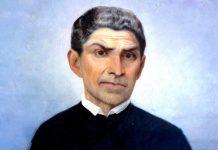Monsignor Marco Agostini, Pontifical Master of Ceremonies, reflects on one of the most delicate moments of the conclave and its spiritual significance.
Newsroom (08/05/2025 08:15, Gaudium Press) On the wall of the Last Judgment in the Sistine Chapel, on either side of the altar, there are two small, closed doors. The one on the left leads to the so-called “room of tears or weeping” (“Stanza delle Lacrime” in Italian). Immediately after the election, the newly elected pope retreats into it to pray for a few minutes. On entering the room, the newly elected pope finds three white cassocks, one small, one medium and one large, prepared in advance to clothe the Successor of Peter.
Monsignor Marco Agostini, Pontifical Master of Ceremonies, explains: “there, the Pope becomes aware of what he has become, of what he is from that moment on.”
On one of the walls of the Room of Tears, there is a stone dated May 31, 2013 that reads:
“In this room, called ‘of tears’ since Gregory XIV, who here, on December 5, 1590, newly elected Pope, shed tears of emotion, the new Pontiff, after accepting the election, wears the appropriate attire”.
The Room of Tears is the place where the newly elected Pope gathers in prayer and changes his vestments. What are the formal characteristics of this small room?
It is a very small, even narrow room, consisting of two staircases – one to go up and one to go down – and a window. It is located just behind Michelangelo’s great work of the Last Judgment, on the wall where Perugino’s fresco of the Assumption was also painted, which we no longer see, but which we can imagine and which we know thanks to a drawing. Therefore, it is in this place that the Pope changes his vestments with a supernatural perspective.
What happens in this place is important from a symbolic point of view. At that moment, the Pope becomes aware of what he has become, of what he is from that moment on. The change of vestments expresses the profound change in his existence. In this place, he understands that the office is greater than the person. Perhaps this is where the name “room of tears” comes from: because at the moment when the new Pontiff realizes that the figure of the Pope is much greater than the person who embodies it, he also understands that, in this role, he will have to die every day, so that not his person, but his office may stand out; so that the Vicar of Christ, the successor of Peter, can emerge today, after more than two hundred Popes.
Is the newly elected pope alone or does someone assist him?
He is usually assisted by the master of ceremonies. I cannot say anything more because I was never present and did not see the scene directly. We know that the cardinal-elect is escorted to that door, under the Last Judgment, to the left of the altar, and disappears with the master of ceremonies; and from there he emerges in the pontifical vestments.
We are living in the Year of Jubilee, we are crossing the Holy Door. Does crossing the threshold of the Hall of Tears also mark a profound change?
It is a very profound change, and a very special threshold is crossed, because it touches the intimacy of the person who becomes Pope. We could say that it touches the heart of the Petrine Ministry: a man who becomes Pope, a cardinal who becomes Pope. We call him Pope, but when we use the terminology with which Pontiffs have historically been designated, we say Vicar of Christ, Successor of Peter and, as Saint Catherine of Siena defined him, the “sweet Christ on earth”. It is splendid! But, I repeat, to contemplate this vision, we need a supernatural gaze, we need the gaze of faith.
- Raju Hasmukh with files from Vatican News






























